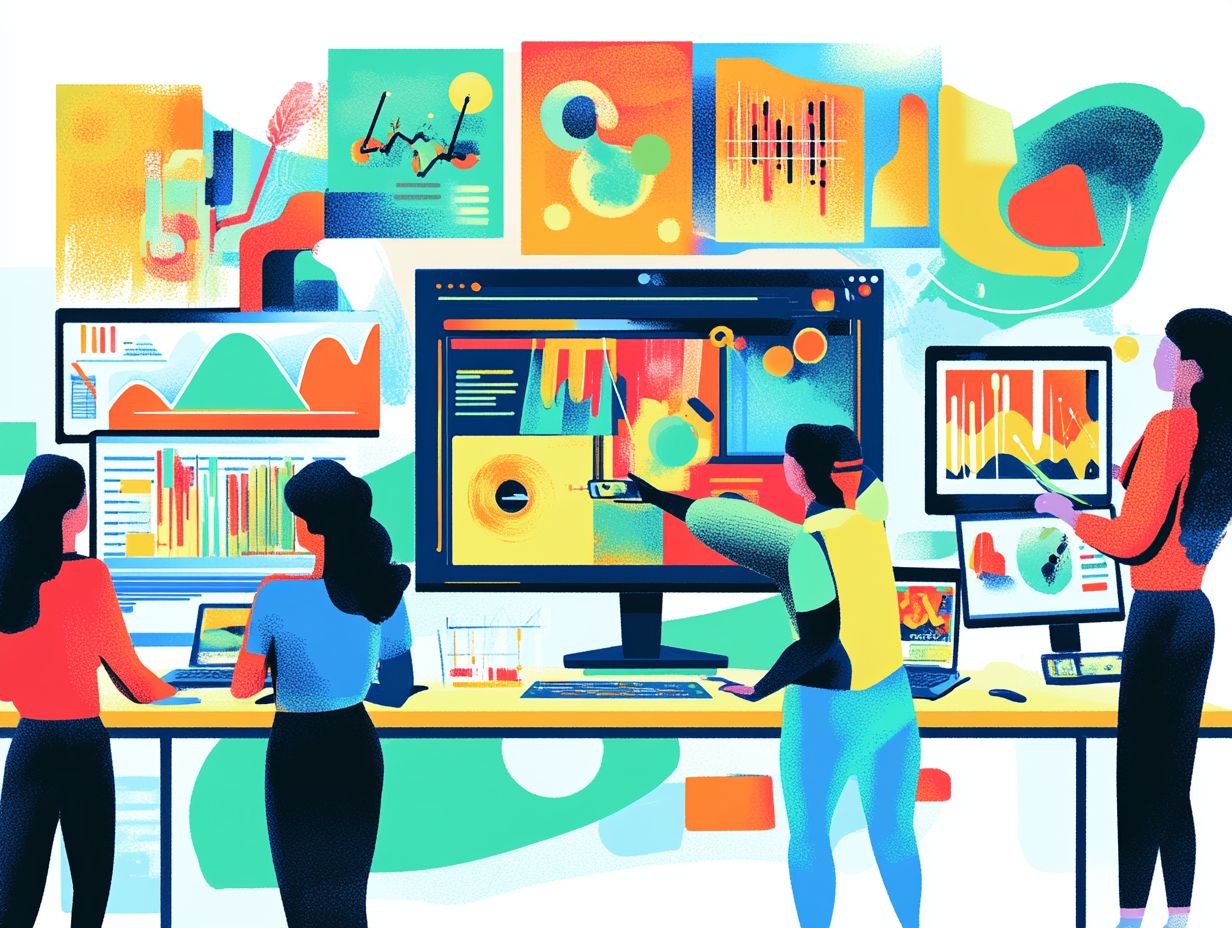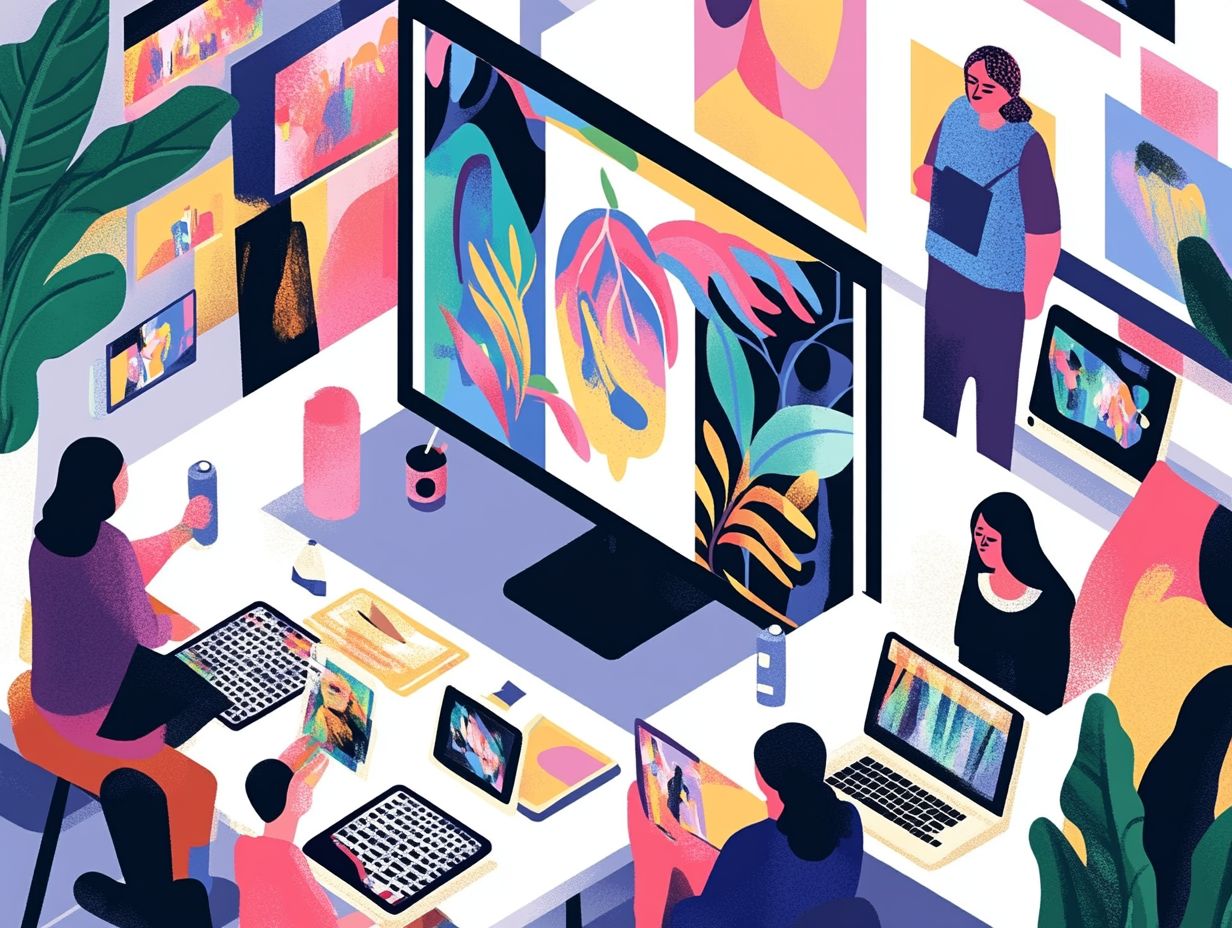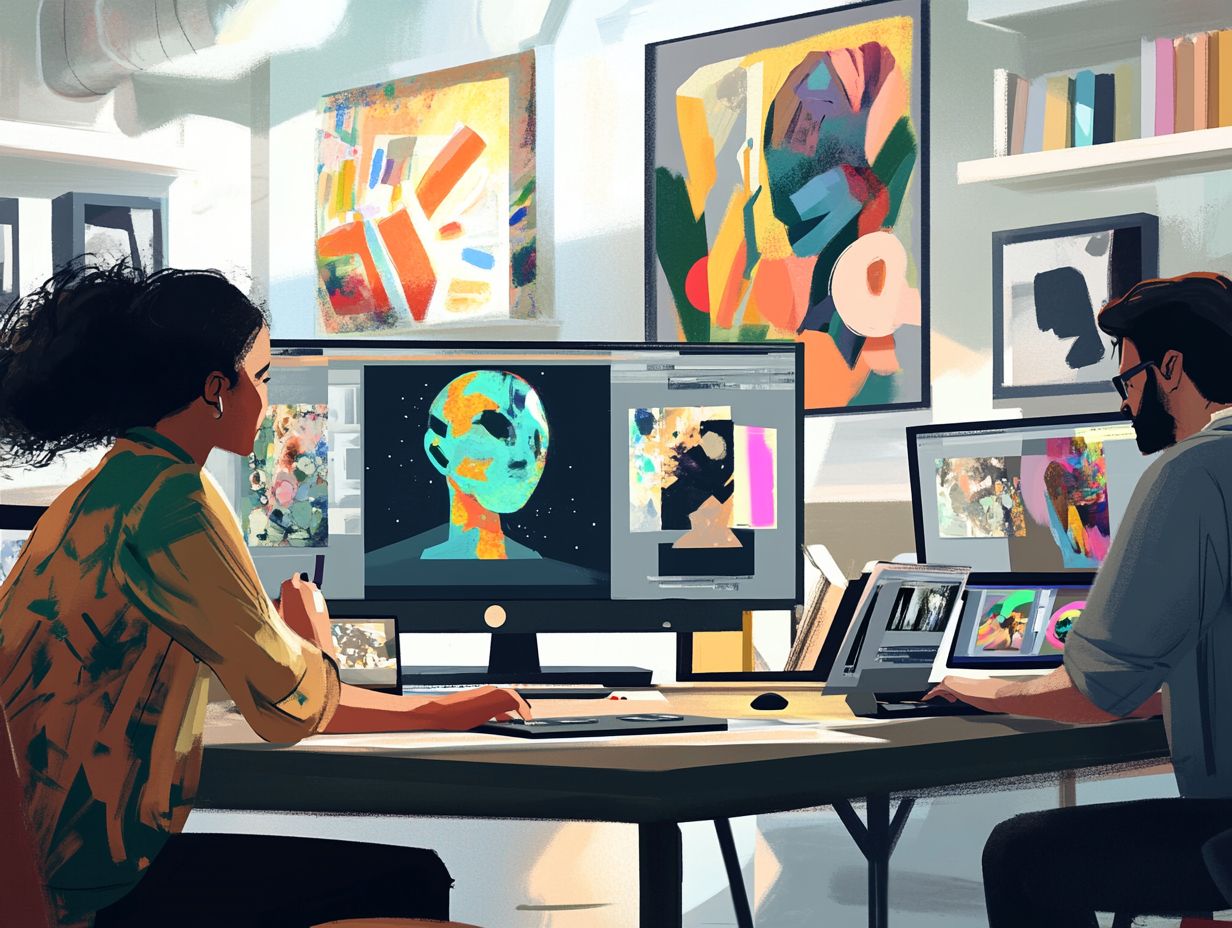In today’s digital landscape, I recognize that picture technology, including AI image generation and photo enhancement, is fundamentally transforming how we create, edit, and analyze images.
This article explores the numerous benefits of utilizing the best AI picture tools, highlighting their role in boosting efficiency and accuracy while also enhancing creativity and customization.
I will examine the various types of these innovative tools, including AI art generators and digital art tools, and discuss key factors to consider when selecting the right one to meet your specific needs.
Additionally, I will showcase some of the top AI picture tools available in the market today, providing a comprehensive overview and comparison to assist you in making an informed decision.
Whether you are a professional or a hobbyist, this guide aims to give the power to you to leverage the potential of these tools in your visual projects, including creative applications like portrait generation and landscape creation.
What is AI Picture Technology?

AI Picture Technology includes tools powered by machine learning and deep learning.
AI Picture Technology includes a comprehensive suite of tools, such as AI image generation and image manipulation, that harness the power of artificial intelligence to transform how I create and enhance visual content. Utilizing deep learning and neural networks, these advanced picture tools enable me to generate images from text prompts (text-to-image), edit photographs, and effortlessly enhance image quality. This innovation makes graphic design more accessible and user-friendly than ever before, providing a user-friendly interface for all users.
I am witnessing the rapid evolution of this technology, which expands the possibilities for both professional designers and amateur creators alike.
The significance of AI Picture Technology extends across various industries, including advertising, gaming, and social media, where high-quality visual content is crucial. By employing machine learning algorithms, this technology analyzes vast amounts of data to produce stunning and contextually relevant images, allowing me to concentrate on creativity rather than labor-intensive tasks like image synthesis.
From automated image retouching to the creation of lifelike 3D renders, the applications are virtually limitless. As industries increasingly adopt this technology, it not only enhances productivity but also promotes innovation, enabling me to explore new artistic avenues with greater ease.
Benefits of Using AI Picture Tools
The use of AI picture tools, including image editing software and photo filters, offers numerous benefits.
I find that utilizing AI picture tools offers numerous benefits that significantly enhance both the efficiency and accuracy of visual content creation and real-time rendering.
These advanced technologies streamline my workflows, enabling me to produce high-quality images at an unprecedented speed while providing a wide range of customization options, including customizable templates, tailored to specific branding and marketing requirements.
Consequently, I can leverage these tools to boost productivity and engage my target audiences more effectively.
Efficiency and Accuracy
The AI algorithms used in these tools are key to their success.
One of the standout advantages of AI picture tools is their ability to significantly enhance efficiency and accuracy in the design process. By utilizing algorithms and machine learning techniques, I can automate time-consuming tasks such as image enhancement, including photo enhancement and batch processing. This allows me to focus on the more creative aspects of my projects, resulting in higher productivity and improved performance metrics.
In today’s fast-paced digital landscape, these tools have become invaluable assets.
For instance, many AI-driven platforms offer features like automatic background removal and intelligent color adjustments, which streamline my workflows and reduce manual effort, especially in image editing software. By analyzing historical design data, these tools can suggest optimized layouts and styles tailored to specific audiences.
This functionality not only saves time but also leads to more consistent and visually appealing outcomes, demonstrating the powerful impact of integrating AI into my design processes. Ultimately, leveraging these advanced technologies can lead to significant improvements in overall design quality and effectiveness.
Enhanced Creativity and Customization

These tools promote visual storytelling and enhance image quality.
AI picture tools have significantly expanded my creative and customization capabilities as a designer, allowing me to craft unique visual narratives that truly resonate with my audience. With features such as style transfer and text-to-image generation, I have the opportunity to explore imaginative art possibilities and personalize my designs to a great extent, leveraging artistic styles and vector graphics.
This give the power tos me to engage in effective visual storytelling, enhancing the user experience across various platforms.
These innovative tools cater not only to my professional needs but also to those of hobbyists, fostering a community where everyone can express their artistic vision. By integrating intuitive interfaces and adaptive algorithms, these resources facilitate easy experimentation with colors, textures, patterns, and output formats, all tailored to my preferences.
This seamless blend of technology and artistry encourages an environment where my imaginative concepts can come to life, enriching my creative process while embracing innovation. Ultimately, the journey from concept to creation, supported by innovative design software, transforms into a shared adventure in creativity.
Types of AI Picture Tools
AI picture tools also include GANs and real-time rendering capabilities.
AI picture tools are available in a variety of forms, each designed to meet specific needs in graphic design and visual content creation.
I utilize image recognition and analysis tools that accurately identify elements within photographs, as well as advanced image editing and enhancement tools that transform raw images into polished masterpieces.
These technologies leverage machine learning and deep learning algorithms to provide exceptional results and functionality, significantly improving my workflow and the quality of my visual content.
Image Recognition and Analysis Tools
These tools are essential for visual communication and content strategy.
I recognize that image recognition and analysis tools powered by AI play a vital role in enhancing the quality and relevance of visual content. By utilizing advanced machine learning and deep learning techniques, I can accurately identify objects, scenes, and key features within images. This capability is invaluable for a range of applications, from automated tagging to content moderation, enhancing user experience and visual effects.
These systems significantly streamline visual content management by automating processes that were once labor-intensive and time-consuming. Their capacity to analyze vast datasets enables me to extract valuable insights, improve user experience, and facilitate better decision-making.
Integrating these tools into my workflow can enhance marketing strategies by ensuring that the right visuals are paired with relevant content, ultimately boosting engagement. As these technologies continue to evolve, I will leverage them to support various industries in optimizing their visual assets and maximizing the impact of their online presence.
Image Editing and Enhancement Tools

These tools are vital for interactive design and digital assets.
AI-driven image editing and enhancement tools have fundamentally transformed the graphic design landscape, offering me a comprehensive range of capabilities to refine and improve my images. These tools come equipped with advanced features such as resolution enhancement, photo enhancement, filtering options, and automated design suggestions, enabling me to produce visually appealing and high-quality outputs with relative ease.
The ability to seamlessly apply filters and make precise adjustments allows me to cater to both novice and expert designers looking to elevate their work. The integration of AI algorithms and machine learning ensures that even complex edits can be executed efficiently, significantly minimizing the time spent on repetitive tasks.
The significance of photo editing goes beyond mere aesthetics; it is crucial for branding, content strategy, and crafting compelling visual narratives. Ultimately, the right image editing software serves as an critical ally for anyone seeking to engage their audience and communicate their message effectively.
Factors to Consider when Choosing AI Picture Tools
Consider the user-friendliness and scalability of the tool.
When I select AI picture tools for my projects, I consider several factors that can significantly influence my decision.
Cost and compatibility with my existing design software are essential elements, along with the features each tool offers and their overall user-friendliness.
By carefully weighing these aspects, I can choose the right tools that align with my workflow and creative objectives.
Cost and Compatibility
Investigate licensing options and cloud-based solutions.
When evaluating AI picture tools, I prioritize cost and compatibility, as these factors can significantly influence my budget and overall productivity.
Understanding the various pricing models—whether subscription-based or one-time purchases—along with the associated licensing terms, and free trials, allows me to make informed decisions that align with both my financial and operational requirements.
Selecting the right tool requires me to consider not only the initial expenses but also the potential ongoing costs related to maintenance and updates, ensuring cross-platform compatibility. This proactive approach helps ensure that I won’t be caught off guard by hidden fees down the line.
It’s also essential for me to assess compatibility with my existing software and workflows. This evaluation can facilitate smoother integration and enhance overall efficiency. The range of pricing models available caters to diverse user bases, from individual freelancers to large enterprises, offering flexibility in accessing services and facilitating collaboration features.
Additionally, I recognize that licensing options can vary, impacting ownership and usage rights, which in turn may influence future scalability and iterative learning as my needs evolve.
Features and User-Friendliness

Features such as watermarking and image compression are essential.
When selecting AI picture tools, I find it essential to evaluate the available features and assess the user-friendliness of the platform. A tool with an intuitive design enhances my user experience and encourages my creativity by providing a seamless workflow, fostering artistic inspiration.
Additionally, strong community support and comprehensive tutorials can significantly aid me in maximizing my experience, encouraging community sharing.
These factors are particularly important for individuals like me who may not have a background in graphic design but wish to create stunning visuals. User-friendly AI tools allow me to navigate complex functions easily, simplifying what can otherwise be an overwhelming process.
An engaged user community provides invaluable insights and encouragement, creating a space for sharing techniques, ideas, feedback, and user-generated content. This collaborative environment fosters learning and builds confidence, enabling me to explore and expand my artistic capabilities with AI art generators, ultimately leading to a richer creative journey.
Top AI Picture Tools in the Market
The market for AI picture tools is experiencing rapid growth, presenting a diverse range of options tailored to meet varying needs and preferences.
From well-established software like Adobe Photoshop to cutting-edge platforms such as DALL-E, Midjourney, and Stable Diffusion, I can select from an array of solutions that address different facets of image generation, editing, design, and computer vision.
It is essential for me to understand the key differences among these tools in order to make an informed decision regarding the best AI picture tools.
Overview and Comparison
In this section, I will provide an overview and comparison of leading AI picture tools such as DALL-E, Midjourney, Stable Diffusion, and Adobe Photoshop. I will highlight key features, pricing, and user experiences associated with each tool. These platforms represent the latest advancements in AI technology, equipped with a range of functionalities that cater to diverse creative needs, from professional graphic design to casual artwork creation, including AI algorithms and generative adversarial networks (GANs).
As I explore these innovative platforms, it’s clear that while they all utilize advanced algorithms to generate striking visual content, each one presents distinct advantages tailored to specific tasks. For example, DALL-E is renowned for its remarkable ability to interpret and transform nuanced textual inputs into detailed images, including high-resolution images, making it a preferred choice for users seeking unique compositions.
Conversely, Midjourney emphasizes community-driven feedback, allowing users to refine their artistic vision through collaborative exploration. Meanwhile, Stable Diffusion stands out with its open-source nature, attracting developers and creatives who are eager to customize their workflows, making it suitable for both online tools and mobile applications. Adobe Photoshop, a longstanding leader in the industry, integrates AI features to enhance its traditional strengths, ensuring users have both flexibility and power at their fingertips, ideal for creating marketing graphics and social media graphics.
By evaluating pricing options and user experiences across these platforms, I aim to provide insights into how they accommodate varying budgets and preferences, including considerations for subscription services and user reviews.
